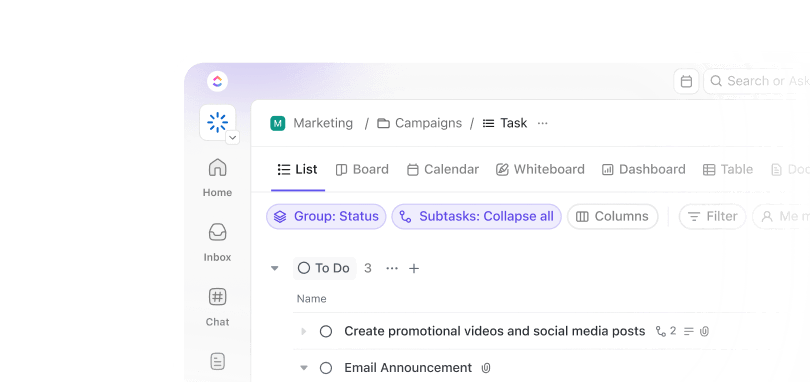Does your workday feel like Groundhog Day? You wake up, tackle the same email replies, manually update the same spreadsheets, and go through yet another round of approvals, only to do it all again tomorrow.
Many businesses are stuck in the pre-internet age of repetitive and soul-sucking tasks that drain productivity and often lead to employee burnout.
The Stepstone Group recently reported that an average full-time employee spends about 8.7 hours per week on repetitive tasks.
But hey! As it turns out, transitioning to an automated workflow isn’t as complicated as you thought! This article will show you exactly how to automate manual business processes, saving time, cutting costs, and boosting productivity.
How to Automate Manual Business Processes for Efficiency
⏰ 60-Second Summary
Wondering how to automate manual business processes? Here’s a step-by-step process:
- Identify: Pinpoint repetitive, time-consuming tasks within your current workflows
- Scope: Define clear goals and choose the right automation tools
- Develop: Design and build automated workflows that align with your business requirements
- Test: Closely track the performance of your automated processes and gather feedback
- Monitor: Continuously refine and improve your automated workflows based on data and feedback
- Collaborate: Involve your team in the process and encourage their feedback for continuous improvement
- Lastly, don’t forget to take help from AI-powered automation tools like that make no-code automations a breeze!
Understanding Manual Processes
Manual processes are workflows or tasks performed without the assistance of automation or advanced technology. These processes rely on human effort, physical tools, or basic software with minimal interconnectivity. They are typically labor-intensive and require manual input at every stage, making them prone to inefficiencies and errors.
Some common examples of manual processes include:
- Data entry: Inputting data manually from paper forms or emails into spreadsheets or other systems
- Invoice processing: Manually generating, sending, and reconciling invoices without automated billing software
- Approval workflows: Physically signing off or email-based approvals instead of digital, trackable systems
- Employee onboarding: Collecting documents, filling out forms, and conducting orientations without a centralized platform
- Inventory management: Using paper logs or standalone spreadsheets to track stock levels and reorder needs
- Scheduling and task assignment: Coordinating work schedules or task assignments via email chains or physical boards
- Customer Relationship Management (CRM): Maintaining customer information and interaction logs manually instead of using CRM software
Common challenges associated with manual processes
These manual processes often lead to bottlenecks, errors, and inefficiencies that hinder business growth and operational excellence.
While these processes are essential, they tend to affect your productivity. Here are some challenges of manual processes.
Time-consuming
Every business has mind-numbing, repetitive manual tasks, be it sorting emails or assigning daily responsibilities. While these seem minor in isolation, they collectively devour countless hours that could otherwise go toward strategic and creative initiatives.
Just think about it. It’s 9 AM, and instead of grabbing coffee and enjoying a fresh start to your workday, you’re stuck in a loop of monotonous work. It’s no fun for anybody!
Prone to human errors
Imagine approving a million-dollar invoice because someone missed a decimal—ouch! Manual errors like this may lead to problematic outcomes, especially in data-sensitive fields like finance or regulated industries.
A simple typo or oversight can derail projects, disrupt workflows, and cost businesses a fortune (not to mention your dignity in team meetings).
👀 Did You Know? Mizuho Securities, a Japanese company, lost over $225 million due to a typographical mistake in a stock trade in 2005—a costly reminder of how manual data entry can lead to errors.
High labor costs
Every task that requires manual intervention also demands labor hours, which results in monetary expenditure. Whether hiring additional staff or paying overtime to complete processes, the reliance on human effort for repetitive tasks can unnecessarily inflate operational costs.
Lack of standardization
Ready for a truth bomb? One of the biggest problems managers face is getting everyone to follow the same steps for consistent results. This often leads to confusion and delayed work.
Employees may do things their way without proper Standard Operating Procedures (SOPs). It’s like asking five people to make the same dish without a recipe. One dish is too salty, one is burnt, and no one knows what went wrong.
But does that make you a bad manager? Absolutely not! You just need the proper process.
Limited scalability
Relying on manual processes to handle tasks means your available human resources are limited.
If your business scales up, taking on more clients, handling larger data sets, or managing multiple stakeholders, your current business processes might buckle under the pressure.
Inefficient collaboration
Collaborations at work should be fun, not like a never-ending email tennis match of “Hey, did you approve this?” and “Oh, I thought you did!”
Add in some meetings, and the delays pile up. This results in endless communication threads that fail to communicate effectively, leaving everyone drained and frustrated.
📮 Insight: 83% of knowledge workers rely primarily on email and chat for team communication. However, nearly 60% of their workday is lost switching between these tools and searching for information.
With an everything app for work like , your project management, messaging, emails, and chats all converge in one place! It’s time to centralize and energize!
Benefits of Automating Manual Processes
All of these irregularities can be solved with a straightforward solution: automation.
Here are some ways automation can help your business.
- Digital transformation: Automating processes is like upgrading your business from analog to digital. It replaces mountains of paperwork and manual data entry with sleek, digital workflows
- Save company time: Why spend hours on repetitive tasks when automation can finish them in seconds? Free up your team’s schedule for more strategic and creative work
- Reduce human intervention: Say goodbye to constant micromanagement. Incorporating robotic process automation (RPA) in your business takes care of routine tasks, reducing the chances of errors
- Improve operational efficiency: Automation simplifies processes, helps use resources efficiently, speeds up tasks, reduces errors, and keeps workflows consistent for better overall efficiency
- Smoothen collaboration: No more chasing emails for updates! Automation centralizes information and makes it easier for teams to share updates through comments on specific tasks and stay on the same page at any given time
- Increase customer satisfaction: When you save time on tasks, you focus more on developing the quality of your business. An automation example in customer service would include automated update emails
In short, automation doesn’t just fix inefficiencies; it improves your business overall.
🧠 Fun Fact: The Harvard Business Review reported that 60% of employees feel automation has increased their productivity and quality of work, making their jobs safer.
How to Automate Manual Processes
How do you get started with your business process automation? You can refer to countless examples of business process automation available online, but not all of them would work for you.
You must experiment and create a unique workflow process that meets your requirements. Here’s a step-by-step guide to get you started:
Step 1: Identify process improvements
Before jumping directly into automation, take a step back and assess your existing processes. Ask yourself these questions.
- What is your current workflow?
- What tasks take up the most time?
- How many of them can be automated?
These questions will help you pinpoint the process ready for a digital glow-up. To make this process easier, use business process automation tools.
is the best task automation software that helps you automate business processes, collaborate, and track progress all in one platform.

Use tools like Mind Maps to visualize your workflow and easily identify areas for improvement at a glance.
💡Pro Tip: Bring your team into the mix, collaborating with them to work together in real time. Need to connect your visual brainstorming—with sticky notes, shapes, and connectors—to actual tasks? Try out Whiteboards and make the act of refining your workflow a lot more fun!
Step 2: Scope out the automation requirements
Once you’ve mapped out inefficiencies, it’s time to set clear goals. What outcomes do you want from automation? allows you to create custom task types that are tailored to different aspects of your business.
Whether you manage customer inquiries, track project milestones, or handle HR processes, you can define each type of task with unique Custom Fields and Statuses that reflect its purpose.


Use ’s Custom Fields to add specific information relevant to each task type, such as dropdowns for priority levers or formulas for calculating progress.
📌 Example: If you’re tracking marketing project categories, you can create a dropdown Custom Field with options like “Paid Media,” “Organic Content,” and “User-Generated Content.” Add unique fields to capture important details, like publishing deadlines or channel types.
This helps maintain consistency in information recording. Save these custom task types as templates for reusing across your organization.
Step 3: Develop the automation
With your tasks defined, it’s time to automate them! Automations allow you to set up recurring tasks and create triggers that initiate actions automatically.


You’d think it requires coding skills. It does not! It’s like a domino—one action triggers the other in perfect sync, ending in the automatic execution of even the most tedious tasks.
📌 Example: Say your team marks a design task as ‘complete.’ You can create custom automation that instantly notifies you for approval and schedules a quality check with a deadline. This keeps you accountable and ensures no derailment in progress.
There is no longer a need for manual reminders that we might forget to give. With just a few clicks, you can save the risk of avoidable oversight on all tasks involved!
Step 4: Closely monitor the automation early on
Once your automation process is live, monitor it closely and test what works for your team.


Choose from the 15+ Views to track your work in a way that makes sense for your team. Use the List View for detailed task management, the Calendar View for deadline tracking, and the Gantt View to view all your milestones and dependencies.
These views are entirely customizable, so you can tweak them however you want. You can also filter the tasks by status, assignees, and more to further bring order to your business process management.


In addition, Dashboards provide a real-time overview of your workflows and allow you to track KPIs effectively.
From employee workloads to project timelines, these dashboards let you keep tabs on everything and automate your business reporting.
Step 5: Optimize the automation over time
As convenient as automation is, it still needs some level of human oversight. So, don’t just set it and forget it.
offers the most robust reporting tools for automation. Our reporting software allows you to build all-in-one dashboards as your mission control center.
It’s as easy as adding measurement cards and charts, dropping in your data, and customizing visuals. You can see all the work at a high level to manage people, tasks, time, documents, embeds, and sprints in one place.


Set your quarterly goals and track every employee’s work in a single dashboard. Resource management helps you visualize how well you’re leveraging your team, and workload analysis shows how productive your team is by tracking task completion.
The end goal? Identifying what you’re doing well and removing bottlenecks in your processes through effective automation. By visualizing every step of your workflow, you’ll run tighter teams and produce better work.
📮 Insight: We recently discovered that about 33% of knowledge workers message 1 to 3 people daily to get the context they need. But what if you had all the information documented and readily available?
With by your side, context switching becomes a thing of the past via automated updates.
Want a quick summary of the team’s progress without going through the dashboard? Use Brain, your AI-powered assistant!


Brain has an answer for every project-related question because it sources its information from your own workspace—tasks, meeting notes, and even chat conversations. This means you only get what you need with no added fluff and 100% accuracy!
You can also use it to build custom automations in using prompts in natural language.


Bonus Step 6: Engage your team for consistent improvement
Your team is your biggest asset—so involve them! Add comments in tasks to gather feedback on automated workflows and encourage suggestions for improvement.
Schedule regular check-ins to discuss what’s working and brainstorm ideas for optimization.
Everything from ideation to implementation and reporting happens here at :
- Identify repetitive and time-consuming tasks
- Save time by creating templates for task types and fields to match your business needs
- Trigger automated notifications and reminders so all the deadlines are met
- Get real-time insights into your automations
- Productively collaborate with your team and keep all tasks and conversations in the same place
’s user-friendly interface and completely customizable features help you finally say goodbye to those dreaded manual tasks:
💡 Pro Tip: Don’t start from scratch. To fast-track automation, use templates tailored to your industry, such as ones for customer onboarding workflows or marketing campaign trackers.
Best Practices for Successful Process Automation
Automating your business process management is a journey, not a destination. Follow these best practices to ensure a smooth and successful transition.
Start small
Don’t try to automate everything at once. Begin with a single, well-defined process within a specific department. This allows you to test the waters, identify potential challenges, and refine your approach before scaling automation efforts across the organization.
Engage stakeholders from day one
Automation significantly changes your workflow, so make sure you involve multiple stakeholders from the planning phase.
This keeps everyone invested in the process and helps them understand the automation goals. Gather input from employees, managers, and even customers to identify pain points and areas for improvement.
Standardize the process
Before implementing any automation, define, document, and standardize your process across the organization. This lays the foundation for a smooth and successful transition to automated workflows.
Consider creating and implementing Standard Operating Procedures (SOPs) for all key processes so even a newbie can use the platform with minimal manual guidance.
Test extensively
Thoroughly test your automated workflows before finalizing them. Monitor performance closely after implementation. Track key metrics such as processing time, error rates, and customer satisfaction.
This allows you to identify and address any issues promptly, ensuring the automation delivers the expected results.
Incorporate artificial intelligence
AI can significantly enhance your automation efforts. So, use it as much as possible to make your life easier. Explore AI-powered solutions for data analysis, predictive modeling, and customer service tasks.
It helps you identify patterns, make more informed decisions, and personalize customer experiences.
Maintain human oversight
While automation can significantly reduce human intervention, it’s crucial to maintain a degree of human oversight. Some tasks will always require human judgment, creativity, and critical thinking.
Balance automation with human oversight to ensure the best possible outcomes.
By following these best practices, you can maximize the benefits of process automation, improve workflow efficiency, and successfully transition to automation without being overwhelmed by the technological side of it.
Break Free From Paper Chains with
Repetitive tasks are like tiny pebbles in your shoes—you bear with them at first, but over time, they frustrate and slow you down. Remember the feeling when you can finally take these pebbles out? That’s what automation feels like.
But why should you choose to automate?
It’s the ultimate platform for process automation, with custom automations, dashboards, and an intelligent AI assistant. It is your key to smoother workflows, happier teams, and satisfied customers. So, why settle for monotony when innovation is just a few clicks away?
It’s pretty simple. Start small, involve your team, and tweak as you go. Before you know it, you’ll wonder how you ever managed without automation.
Ready to get automatin’? Sign up for a free account now!


Everything you need to stay organized and get work done.













